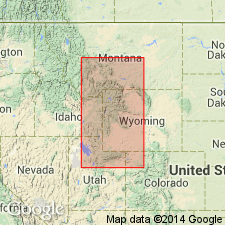
- Usage in publication:
-
- Shedhorn sandstone*
- Modifications:
-
- Named
- Dominant lithology:
-
- Sandstone
- Chert
- AAPG geologic province:
-
- Montana folded belt
Summary:
Named by Cressman and Swanson (p. 31-33) for Shedhorn Creek, Madison Range, Madison Co, MT in Montana folded belt province. Type section measured in SW1/4 sec 20, T8S, R2E. Occurs also in northwest WY in Yellowstone province and in northeastermost ID in Snake River basin. Is composed mostly of brown to gray, thick bedded to massive bedded, usually fine- to medium-grained sandstone but some beds are coarse grained, and brown-gray, sandy, thin- to thick-bedded, wavy laminated to massive bedded chert. Phosphate pellets present in both lithologies. Is 117.8 ft thick at type where it is separated into a lower member and an upper member by Tosi chert and Retort phosphatic shale tongues (both new) of Phosphoria formation. Franson tongue (new) underlies lower member. Dinwoody formation overlies upper member. Assigned to Permian.
Source: GNU records (USGS DDS-6; Denver GNULEX).
For more information, please contact Nancy Stamm, Geologic Names Committee Secretary.
Asterisk (*) indicates published by U.S. Geological Survey authors.
"No current usage" (†) implies that a name has been abandoned or has fallen into disuse. Former usage and, if known, replacement name given in parentheses ( ).
Slash (/) indicates name conflicts with nomenclatural guidelines (CSN, 1933; ACSN, 1961, 1970; NACSN, 1983, 2005, 2021). May be explained within brackets ([ ]).

